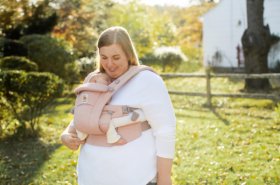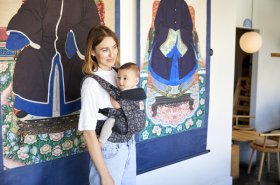Since the 1950s, more doctors have acknowledged the tremendous healing power of bonding with our young through babywearing, physical contact, breastfeeding and family beds. The physical, mental and emotional health benefits are unsurpassed by any drug or remedy known to man with the benefits lasting a lifetime. Hopefully, this article helps parents to bond with their offspring through a means that is biologically compatible with their infants’ needs because our babies are movement-starved.
Bonding is the physical, mental, emotional, and, some might add, spiritual, connection and attachment most parents make with their offspring to varying degrees. It deeply engages all the senses. “The mother is endocrinologically, sensually, as well as neurologically transformed in ways likely to serve the infant’s needs and contribute to her own posterity. The hormone oxytocin, also called the love drug, and known to be as addictive as morphine, is released while breastfeeding, snuggling, or massaging. Or, it can be released even with the thought of the beloved. It reduces anxiety and acts as a “central regulator of stress-protective social behavior.” Deepok Chopra says it “can prevent diseases, boost immunity, and enhance IQ.” Neuroscientist, Dr. Amen writes, “If a man holds a baby, levels of testosterone go down, perhaps, in part, because of oxytocin . . . going up.”
With such powerful bonding chemicals and “feel good” hormones, why do we hear crying or fussing babies, or see exasperated new parents? There are numerous written accounts of rare cultures where parents live in complete harmony with their young, and with each other. What are we missing? I think most parents feel they are doing everything they can for their children, especially given their work hours. But, maybe there IS an easier way.
One book, with an in-depth look at the child rearing practices among Stone Age Indians, is the “Continuum Concept,” by Jean Liedloff. She wrote of the peaceful Yequana tribe who did not focus on their offspring but rather continued their adult activities while carrying them in a sling until the babies crawled. Their infants seldom cried or fussed. The parents I work with who practice the principles of the continuum discover for themselves this same phenomenon. Roughly, Jean’s first continuum principle is always keeping the baby “in arms” of a parent or caregiver: that’s one hundred percent of the time. It means moving with the baby while doing adult tasks. Until they can crawl on their own, infants receive this secure and complete bond. As a consequence, children are significantly more independent, calm, happy, coordinated and self-reliant. As infants mature, the need to be carried or catered to is consistently and dramatically less than the partially bonded infant, (carried only part of the time). “The human species could NOT have survived had we catered to our young,” Jean used to tell me.
We continue getting new information from multiple sources on how beneficial it is to bond through movement with our offspring. Mothers mostly from East and West Africa “talked about carrying babies and infants in slings on their backs as a general practice that is responsible for attachment.” Until an infant can crawl on his own, it is not a stretch to assume his instincts expect a continuation of that same bonding through movement, just as it was in the womb. Dr. Sears states, “Bonding is really a continuation of the relationship that began during pregnancy.” Dr. Small states, “Newborns are not designed, physically or mentally to be on their own.”
Movement is so integral to our being we take it for granted, like the air we breathe. It is impossible to live without it, but we do not pay much attention to it. With our protected and sedentary lifestyle, we have forgotten that moving with our young connected to our bodies is perhaps the most powerful aspect of the child-parent bond.
Cambridge neuroscientist Daniel Wolpert says, “We have a brain for one reason…to produce adaptable and complex movements…There’s no other reason to have a brain. Movement is the ONLY way you have of affecting the world around you…There can be no evolutionary advantage, to laying down memories of childhood, or perceiving the color of a rose, if it doesn’t affect the way you’re going to move later in life. So, it’s really important to remember that sensory, memory and cognitive processes are all important, but they are only important either to drive or suppress future movements.”
Jean Liedloff said continuum babies dwarf “normal” babies in their abilities, and I found this to be very true. They have an enormous neurological advantage from infancy. They feel the ever-changing movements and environments and must continuously adapt by balancing and stabilizing themselves. Their senses are taking in copious amounts of information compared to those babies left to sit limited to one place at a time. They are riding amidst the movement of life: content, free of anxiety and desire. Their inborn safety and security needs are met. This has massive implications on the nature of our society since the brain is basically organized around fear and desire. Most of us do not have the ability to be free of anxious or desirous thoughts. Our brains are busy inhibiting this constant flow of “static,” expressed as anxiety or need, and that unconsciously dictates our decisions, our life.
My clients almost always experience miraculous results on the first day they fully commit to practicing Jean’s “in arms” bonding through movement. The trust and security levels that the infants were missing increases so rapidly and significantly, it is hard to believe, unless one witnesses it first hand. Parents feel better mentally, physically and emotionally. Once parents make the switch to the continuum, they are thrilled to have their time and hands free.
They are less stressed and more productive when baby care and adult activities are done at the same time. Infants stop crying, clinging, fussing, waving arms and kicking, and they often nurse less. Everyone sleeps better and smiles more. Parents quickly learn to read their infant’s feeding and sleeping cues through the baby’s movements. Some mothers feel when their babies need to eliminate and hence stop using diapers during the day. In this deep bond, parents’ and baby’s intuitive faculties are symbiotic.
I find many parents and caregivers fear bonding through movement in this way. It sounds too extreme or impossible to do for a full six to eight months. They have the excuses I had, including lower back pain. But, Jean would listen to none of that when I first called her for help. I leaped, that first day, as an experiment, and never went back. Jean was with me every step of the way.
Try to think of caring for your newborn the same as when he was in the womb, minus dressing, feeding and diaper changes. You can bathe your infant at the same time you bath yourself. The weight of carrying the baby is a non-issue since you get stronger as the baby grows. Do your sedentary work while the baby is sleeping on you. Before long, she pushes away to explore bits of the world. It is not all at once, just a little here and a little there, until she does not want to be carried at all.
The parent-child bond is an ongoing process. It could start out weak, but every moment is an opportunity to strengthen it. Due to the remarkable plasticity of our brains, those lost gaps can be filled with love.
References:
1 Sarah Blaffer Hrdy, Mother Nature: Maternal Instincts and How They Shape The Human Species (Random House, New York, 1999), 537.
2 Patty Onderko, “The New Science of Mother-Baby Bonding”: http://www.parenting.com/article/the-new-science-of-mother-baby-bonding?page=0,1 (last accessed 4 Dec 2011).
3 Hrdy, Mother Nature, 139.
4 Michael Kosfeld, “Trust in the Brain”: http://www.nature.com/embor/journal/v8/n1s/full/7400975.html (last accessed 4 Dec 2011).
5 Onderko, The New Science: http://www.parenting.com/article/the-new-science-of-mother-baby-bonding (last accessed 4 Dec 2011).
6 Daniel G. Amen, M.D. The Brain in Love: 12 lessons to enhance your love life, (New York, Random House Inc., 2007), 67.
7 P.N. Reebye M.D. and team, Research Report: “Beliefs, Values and Practices”: http://www.attachmentacrosscultures.org/beliefs/index.html#11 (last accessed 1 Dec 2011).
8 Drs. Bill, Jim, Bob, Peter Sears and Martha Sears, “Bonding-What it Means”: http://www.askdrsears.com/topics/pregnancy-childbirth/tenth-month-post-partum/bonding-your-newborn/bonding-what-it-means (last accessed 4 Dec 2011).
9 Andrea Elovson, “Surprising Benefits of Slings and Baby Carriers!”: http://www.babyzone.com/baby/nurturing/article/slings-carriers-benefits (last accessed 4 Dec 2011)
10 TED Talks, Daniel Wolpert: “The real reason for brains.” http://www.ted.com/talks/daniel_wolpert_the_real_reason_for_brains.html?awesm=on.ted.com_Wolpert&utm_campaign&utm_medium=on.ted.com-static&utm_source=t.co&utm_content=awesm-publisher&mid=51
TED Talks, Helen Fisher is an anthropologist with Rutgers University, specializing in gender differences and the evolution of human emotions. Her most recent book is Why We Love: The Nature and Chemistry of Romantic Love. In this wide-ranging talk, she outlines the bio-chemical foundations of love, and discusses the natural talents of women, and their new significance in the modern world. (Recorded February 2006 in Monterey, CA. Duration: 24:13)
http://blog.ted.com/2006/09/06/helen_fisher_on/



